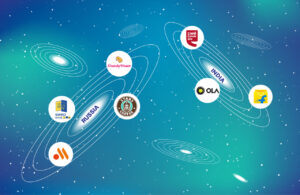The rise of brand nationalism
Brand nationalism is growing in our increasingly multipolar world.
Not since the end of the Cold War has the geopolitical stage witnessed such a dramatic reshuffling of power. The world is now firmly multipolar, with several power brokers vying to shape the new order, coalesce ecosystems, influence culture, and dominate trade. Nationalism is expected to continue its spread as more than 40 countries go to the polls in 2024, the largest number of people voting in history. The era of hyper-globalization has now been replaced with “slowbalization” or “localism.” Slogans such as “America first”, “China first”, “India first”, or “Russia first” are shaping trade and economic strategies.

These forces are creating parallel economic worlds, each with their own galaxies of brands. Increased protectionism, unreliable global supply chains and rising populist sentiment mean that consumers in each of these ecosystems are going about their lives surrounded by brands unique to their own world. Brand nationalism means that travelers moving from one regional vortex to another will find themselves in a different multi-verse of brands.
The growth of local brands—India
Take India, for example. If you are dropping into this world from the West, you will certainly see Starbucks, Uber, and Amazon, but these brands won’t dominate the landscape. Instead, you won’t be able to miss Café Coffee Day, Ola and Flipkart. According to a recent survey, 60% of Indian consumers across all age-groups are seeking to replace foreign brands with indigenous brands, and 41 per cent are even willing to pay a premium for them. The government is supporting local brands in an effort to reduce imports with initiatives such as Atmanirbhar Bharat (self-reliant India), Make in India, and Vocal for Local.
The growth of local brands—Russia
In Russia, this process has been accelerated by force of circumstances. As Western brands have pulled out, and Putin’s propaganda has become ever more vociferously hostile towards the West, Russian brands have rushed in to fill the gap. Lookalike brands include Swed House offers products almost identical to those of IKEA. It has signed contracts with IKEA’s former production sites. McDonald’s has given way to Vkusno & Tochka (Tasty Period). Krispy Kreme has been replaced by Krunchy Dream; Lush by Oomph. Starbucks has been supplanted by Stars Coffee, whose social media bio reads “the bucks have left, but the stars remain.” These new brands are still much smaller than their predecessors. Swed House employs 100 people among 10 shops, but plans to double the number this year. As Alexandra Prokopenko, of the Carnegie Russia Eurasia Center says, “what’s happening is a kind of nationalization of the Russian economy.”
What brand nationalism means for global brands
Brand nationalism must figure into the plans of any brand with ambitions to play in a different brand galaxy. They will need to adapt their offerings and messages to fit the national zeitgeist. The idea of localization is not new. But what is new is the greater weight of patriotic fervor, antipathy towards other world powers, and indignant resistance to a global brand invasion. To counter this, global brands must try to instill a sense of belonging and community, source locally available raw materials, partner with local distribution channels, and communicate all this to consumers. And they must continue to offer local variations of products, like McDonald’s with Turmeric Latte and Masala Kadak Chai in India, McCurrywurst in Germany, Teriyaki McBurger in Japan, and the McFalafel in Egypt.
These brand galaxies are becoming breeding grounds for creating and launching of these local brands back out into other regions. As brands grow and mature within each of these parallel vortexes, they eventually reach the scale and ambition to invade other worlds. One such example is China, and our next piece investigates the brand nationalism trend there in more depth.